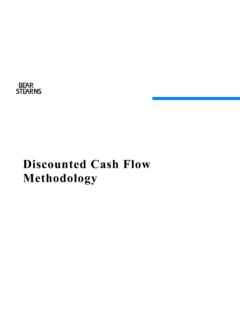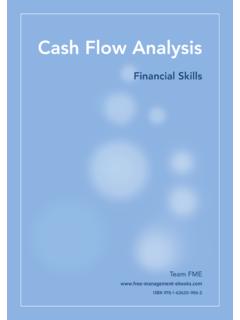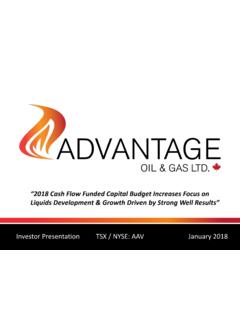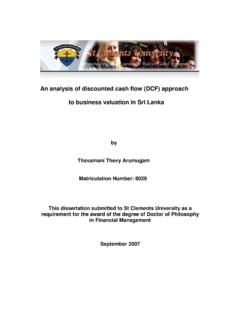Transcription of Discounted Cash Flow Analysis - Graham And Doddsville
1 Updated 08/01/2007 Discounted Cash Flow Analysis By Ben McClure very much for downloading the printable version of this tutorial. As always, we welcome any feedback or suggestions. Table of Contents 1) DCF Analysis : Introduction 2) DCF Analysis : The Forecast Period & Forecasting Revenue Growth 3) DCF Analysis : Forecasting Free Cash flows 4) DCF Analysis : Calculating The Discount Rate 5) DCF Analysis : Coming Up With A Fair Value 6) DCF Analysis : Pros & Cons Of DCF 7) DCF Analysis : Conclusion Introduction It can be hard to understand how stock analysts come up with "fair value" for companies, or why their target price estimates vary so wildly. The answer often lies in how they use the valuation method known as Discounted cash flow (DCF). However, you don't have to rely on the word of analysts. With some preparation and the right tools, you can value a company's stock yourself using this method. This tutorial will show you how, taking you step-by-step through a Discounted cash flow Analysis of a fictional company.
2 In simple terms, Discounted cash flow tries to work out the value of a company today, based on projections of how much money it's going to make in the future. DCF Analysis says that a company is worth all of the cash that it could make available to investors in the future. It is described as " Discounted " cash flow because cash in the future is worth less than cash today. (To learn more, see The Essentials Of Cash Flow and Taking Stock Of Discounted Cash Flow.) For example, let's say someone asked you to choose between receiving $100 today and receiving $100 in a year. Chances are you would take the money today, knowing that you could invest that $100 now and have more than $100 in (Page 1 of 16) Copyright 2005, - All rights reserved. Your Source For Investing Education. a year's time. If you turn that thinking on its head, you are saying that the amount that you'd have in one year is worth $100 dollars today - or the Discounted value is $100.
3 Make the same calculation for all the cash you expect a company to produce in the future and you have a good measure of the company's value. There are several tried and true approaches to Discounted cash flow Analysis , including the dividend discount model (DDM) approach and the cash flow to firm approach. In this tutorial, we will use the free cash flow to equity approach commonly used by Wall Street analysts to determine the "fair value" of companies. As an investor, you have a lot to gain from mastering DCF Analysis . For starters, it can serve as a reality check to the fair value prices found in brokers' reports. DCF Analysis requires you to think through the factors that affect a company, such as future sales growth and profit margins. It also makes you consider the discount rate, which depends on a risk-free interest rate, the company's costs of capital and the risk its stock faces. All of this will give you an appreciation for what drives share value, and that means you can put a more realistic price tag on the company's stock.
4 To demonstrate how this valuation method works, this tutorial will take you step-by-step through a DCF Analysis of a fictional company called The Widget Company. Let's begin by looking at how to determine the forecast period for your Analysis and how to forecast revenue growth. The Forecast Period & Forecasting Revenue Growth The Forecast Period The first order of business when doing Discounted cash flow (DCF) Analysis is to determine how far out into the future we should project cash flows . For the purposes of our example, we'll assume that The Widget Company is growing faster than the gross domestic product (GDP) expansion of the economy. During this "excessive return" period, The Widget Company will be able to earn returns on new investments that are greater than its cost of capital. So, our Discounted cash flow needs to forecast the amount of free cash flow that the company will produce for this period. The excess return period tells us how far into the future we should forecast the company's cash flows .
5 Alas, it's impossible to say exactly how long this period of excess returns will last. The best we can do is make an educated guess based on the company's competitive and market position. Sooner or later, all companies settle into maturity and slower growth. (The common practice with DCF Analysis is to make the excess return period the forecast period. But it is important to note This tutorial can be found at: (Page 2 of 16) Copyright 2007, Investopedia ULC- All rights reserved. Your Source For Investing Education. that this valuation method does not restrict your Analysis to only excess return periods - you could estimate the value of a company growing slower than the economy using DCF Analysis too.) The table below shows good guidelines to use when determining a company's excess return period/forecast period: Company Competitive Position Excess Return/Forecast Period Slow-growing company; operates in highly competitive, low margin industry 1 year Solid company; operates with advantage such as strong marketing channels, recognizable brand name, or regulatory advantage 5 years Outstanding growth company; operates with very high barriers to entry, dominant market position or prospects 10 years Figure 1 How far in the future should we forecast The Widget Company's cash flows ?
6 Let's assume that the company is keeping itself busy meeting the demand for its widgets. Thanks to strong marketing channels and upgraded, efficient factories, the company has a reasonable competitive position. There is enough demand for widgets to maintain five years of strong growth, but after that the market will be saturated as new competitors enter the market. So, we will project cash flows for the next five years of business. Revenue Growth Rate We have decided that we want to estimate the free cash flow that The Widget Company will produce over the next five years. To arrive at this figure, the standard procedure is to forecast revenue growth over that time period. Then (as we will see in later chapters), by breaking down after-tax operating profits, estimated capital expenditure and working capital needs, we can estimate the cash flow the company will produce. Let's start with top line growth. Forecasting a company's revenues is arguably the most important assumption one can make about its future cash flows .
7 It can also This tutorial can be found at: (Page 3 of 16) Copyright 2007, Investopedia ULC- All rights reserved. Your Source For Investing Education. be the most difficult assumption to make. (For more on forecasting sales, see Great Expectations: Forecasting Sales Growth.) We need to think carefully about what the industry and the company could look like as they evolve in the future. When forecasting revenue growth, we need to consider a wide variety of factors. These include whether the company's market is expanding or contracting, and how its market share is performing. We also need to consider whether there are any new products driving sales or whether pricing changes are imminent. But because that future can never be certain, it is valuable to consider more than one possible outcome for the company. First, the upbeat revenue growth scenario: The Widget Company has grown revenues at 20% for the past two years, and your careful market research suggests that demand for widgets will not let up any time soon.
8 Management - always optimistic - argues that the company will keep growing at 20%. That being said, there may be reasons to downplay revenue growth expectations. While the company's revenue growth will stay strong in the first few years, it could slow to a lower rate by Year 5 as a result of increasing international competition and industry commoditization. We should err on the side of caution and conservatism and assume that The Widget Company's top line growth rate profile will commence at 20% for the first two years, then drop to 15% for the next two years and finally drop to 10% in Year 5. Posting $100 million of revenue in its latest annual report, the company is projected to grow its revenues to $ million at the end of five years (based on realistic, rather than optimistic, growth expectations). Forecast Revenue Growth Profiles Current Year Year 1 Year 2 Year 3 Year 4 Year 5 Optimistic: Growth Rate Revenue - $100 M 20% $120 M 20% $144 M 20% $ M 20% $ M 20% $ MRealistic: Growth Rate Revenue - $100 M 20% $120 M 20% $144 M 15% $ M 15% $ M 10% $ MFigure 2 Now that we've determined our forecast period and our revenue growth for that period, we can move on to the next step in our Analysis , where we will estimate the free cash flow produced over the forecast period.
9 This tutorial can be found at: (Page 4 of 16) Copyright 2007, Investopedia ULC- All rights reserved. Your Source For Investing Education. Forecasting Free Cash flows Now that we have determined revenue growth for our forecast period of five years, we want to estimate the free cash flow produced over the forecast period. Free cash flow is the cash that flows through a company in the course of a quarter or a year once all cash expenses have been taken out. Free cash flow represents the actual amount of cash that a company has left from its operations that could be used to pursue opportunities that enhance shareholder value - for example, developing new products, paying dividends to investors or doing share buybacks. (To learn more, see Free Cash Flow: Free, But Not Always Easy.) Calculating Free Cash Flow We work out free cash flow by looking at what's left over from revenues after deducting operating costs, taxes, net investment and the working capital requirements (see Figure 1).
10 Depreciation and amortization are not included since they are non-cash charges. (For more information, see Understanding The Income Statement.) Figure 1 - How free cash flow is calculated In the previous chapter, we forecasted The Widget Company's revenues over the next five years. Here we show you how to project the other items in our calculation over that period. Future Operating Costs When doing business, a company incurs expenses - such as salaries, cost of goods sold (CoGS), selling and general administrative expenses (SGA), and research and development (R&D). These are the company's operating costs. If current operating costs are not explicitly stated on a company's income statement, you can calculate them by subtracting net operating profits - or earnings before interest and taxation (EBIT) - from total revenues. A good place to start when forecasting operating costs is to look at the company's historic operating cost margins. The operating margin is operating costs expressed as a proportion of revenues.








